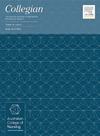The gender pay gap in the Australian nursing workforce: A retrospective observational study
IF 1.7
4区 医学
Q2 NURSING
引用次数: 0
Abstract
Aim
To explore the gender pay gap among the Australian nursing workforce and identify reasons for such a gap.
Background
Gender discrimination exists in nursing, with men having a higher rate of pay and a faster rate of career progression, irrespective of experience and qualifications. In addition, men are shown to have a greater representation in leadership roles compared to the proportion of men in the profession.
Methods
The study uses a retrospective, observational survey design of graduate nurses from all Australian universities.
Findings
The gender wage gap was around 4% at six months after graduation, increasing to 13% at three years after graduation, favouring nurses who are men. Men also reported being more overqualified than women upon graduation. In addition, graduates who were overqualified had a 21% disparity in pay. Nursing graduates from non-English speaking backgrounds and lower socioeconomic backgrounds had an increased probability of being underemployed.
Conclusions
Overall, nurses who were men are earning a higher wage than women nurses upon graduation and at three years post-graduation in Australia. These findings, despite an enterprise bargaining agreement, are consistent with the gender pay disparity gap in Australia and with international research on this topic. Of note from this study is the notion that men are working unsociable hours and weekends and are, therefore, receiving penalty rates that increase their wages. This notion is also consistent with the current ideology in Australia of men being breadwinners despite changes in gender equality in the country.
Implications for nursing management
Organisations need to offer flexible work environments that will allow women to re-enter the workforce while caring for dependents. This can include shorter shifts allowing women to work flexible hours to care for dependents, job sharing with other nurses of similar skill level and working across multiple areas to allow for flexibility. In addition, healthcare organisations should increase support and promote positive practice environments, including wages in order to sustain and retain the future workforce.
澳大利亚护理人员的性别薪酬差距:一项回顾性观察研究
目的探讨澳大利亚护理人员的性别薪酬差距,并找出造成这种差距的原因。护理行业存在性别歧视,无论经验和资历如何,男性的薪酬更高,职业发展速度更快。此外,与男性在该专业中的比例相比,男性在领导角色中的代表性更大。方法采用回顾性、观察性调查设计,对澳大利亚所有大学的研究生护士进行调查。研究发现,毕业后6个月,男女工资差距约为4%,毕业后3年,这一差距增加到13%,这有利于男性护士。男性在毕业时也比女性更大材小用。此外,大材小用的毕业生在薪酬上也有21%的差距。非英语背景和社会经济背景较低的护理毕业生就业不足的可能性增加。总体而言,澳大利亚男性护士在毕业时和毕业后三年内的工资高于女性护士。尽管存在企业讨价还价协议,但这些发现与澳大利亚的性别薪酬差距以及有关该主题的国际研究是一致的。从这项研究中值得注意的是,男性在非社交时间和周末工作,因此得到了提高工资的惩罚率。这一概念也符合澳大利亚目前的意识形态,即男性是养家糊口的人,尽管该国的性别平等有所变化。组织需要提供灵活的工作环境,允许女性在照顾家属的同时重新进入劳动力市场。这可以包括缩短轮班时间,使妇女能够灵活地工作时间来照顾家属,与其他技能水平相似的护士分担工作,以及跨多个领域工作以实现灵活性。此外,医疗机构应该增加支持和促进积极的实践环境,包括工资,以维持和留住未来的劳动力。
本文章由计算机程序翻译,如有差异,请以英文原文为准。
求助全文
约1分钟内获得全文
求助全文
来源期刊

Collegian
NURSING-
CiteScore
2.70
自引率
6.70%
发文量
127
审稿时长
72 days
期刊介绍:
Collegian: The Australian Journal of Nursing Practice, Scholarship and Research is the official journal of Australian College of Nursing (ACN).
The journal aims to reflect the broad interests of nurses and the nursing profession, and to challenge nurses on emerging areas of interest. It publishes research articles and scholarly discussion of nursing practice, policy and professional issues.
Papers published in the journal are peer reviewed by a double blind process using reviewers who meet high standards of academic and clinical expertise. Invited papers that contribute to nursing knowledge and debate are published at the discretion of the Editor.
The journal, online only from 2016, is available to members of ACN and also by separate subscription.
ACN believes that each and every nurse in Australia should have the opportunity to grow their career through quality education, and further our profession through representation. ACN is the voice of influence, providing the nursing expertise and experience required when government and key stakeholders are deciding the future of health.
 求助内容:
求助内容: 应助结果提醒方式:
应助结果提醒方式:


